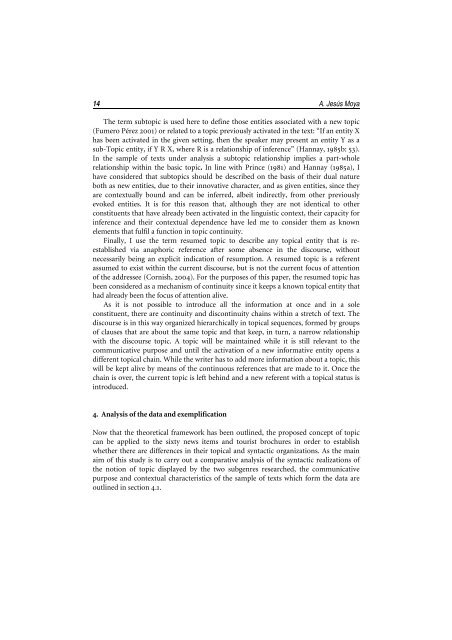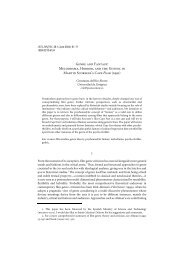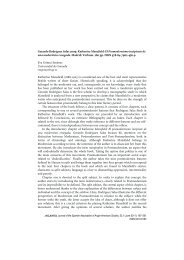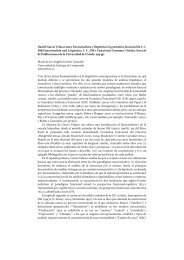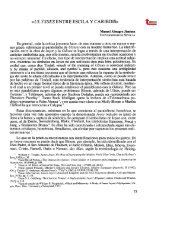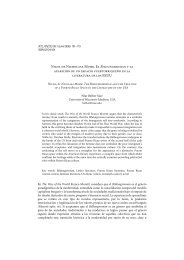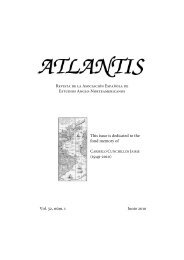On Pragmatic Functions and their Correlation with Syntactic - Atlantis
On Pragmatic Functions and their Correlation with Syntactic - Atlantis
On Pragmatic Functions and their Correlation with Syntactic - Atlantis
Create successful ePaper yourself
Turn your PDF publications into a flip-book with our unique Google optimized e-Paper software.
14 A. Jesús Moya<br />
The term subtopic is used here to define those entities associated <strong>with</strong> a new topic<br />
(Fumero Pérez 2001) or related to a topic previously activated in the text: “If an entity X<br />
has been activated in the given setting, then the speaker may present an entity Y as a<br />
sub-Topic entity, if Y R X, where R is a relationship of inference” (Hannay, 1985b: 53).<br />
In the sample of texts under analysis a subtopic relationship implies a part-whole<br />
relationship <strong>with</strong>in the basic topic. In line <strong>with</strong> Prince (1981) <strong>and</strong> Hannay (1985a), I<br />
have considered that subtopics should be described on the basis of <strong>their</strong> dual nature<br />
both as new entities, due to <strong>their</strong> innovative character, <strong>and</strong> as given entities, since they<br />
are contextually bound <strong>and</strong> can be inferred, albeit indirectly, from other previously<br />
evoked entities. It is for this reason that, although they are not identical to other<br />
constituents that have already been activated in the linguistic context, <strong>their</strong> capacity for<br />
inference <strong>and</strong> <strong>their</strong> contextual dependence have led me to consider them as known<br />
elements that fulfil a function in topic continuity.<br />
Finally, I use the term resumed topic to describe any topical entity that is reestablished<br />
via anaphoric reference after some absence in the discourse, <strong>with</strong>out<br />
necessarily being an explicit indication of resumption. A resumed topic is a referent<br />
assumed to exist <strong>with</strong>in the current discourse, but is not the current focus of attention<br />
of the addressee (Cornish, 2004). For the purposes of this paper, the resumed topic has<br />
been considered as a mechanism of continuity since it keeps a known topical entity that<br />
had already been the focus of attention alive.<br />
As it is not possible to introduce all the information at once <strong>and</strong> in a sole<br />
constituent, there are continuity <strong>and</strong> discontinuity chains <strong>with</strong>in a stretch of text. The<br />
discourse is in this way organized hierarchically in topical sequences, formed by groups<br />
of clauses that are about the same topic <strong>and</strong> that keep, in turn, a narrow relationship<br />
<strong>with</strong> the discourse topic. A topic will be maintained while it is still relevant to the<br />
communicative purpose <strong>and</strong> until the activation of a new informative entity opens a<br />
different topical chain. While the writer has to add more information about a topic, this<br />
will be kept alive by means of the continuous references that are made to it. <strong>On</strong>ce the<br />
chain is over, the current topic is left behind <strong>and</strong> a new referent <strong>with</strong> a topical status is<br />
introduced.<br />
4. Analysis of the data <strong>and</strong> exemplification<br />
Now that the theoretical framework has been outlined, the proposed concept of topic<br />
can be applied to the sixty news items <strong>and</strong> tourist brochures in order to establish<br />
whether there are differences in <strong>their</strong> topical <strong>and</strong> syntactic organizations. As the main<br />
aim of this study is to carry out a comparative analysis of the syntactic realizations of<br />
the notion of topic displayed by the two subgenres researched, the communicative<br />
purpose <strong>and</strong> contextual characteristics of the sample of texts which form the data are<br />
outlined in section 4.1.


